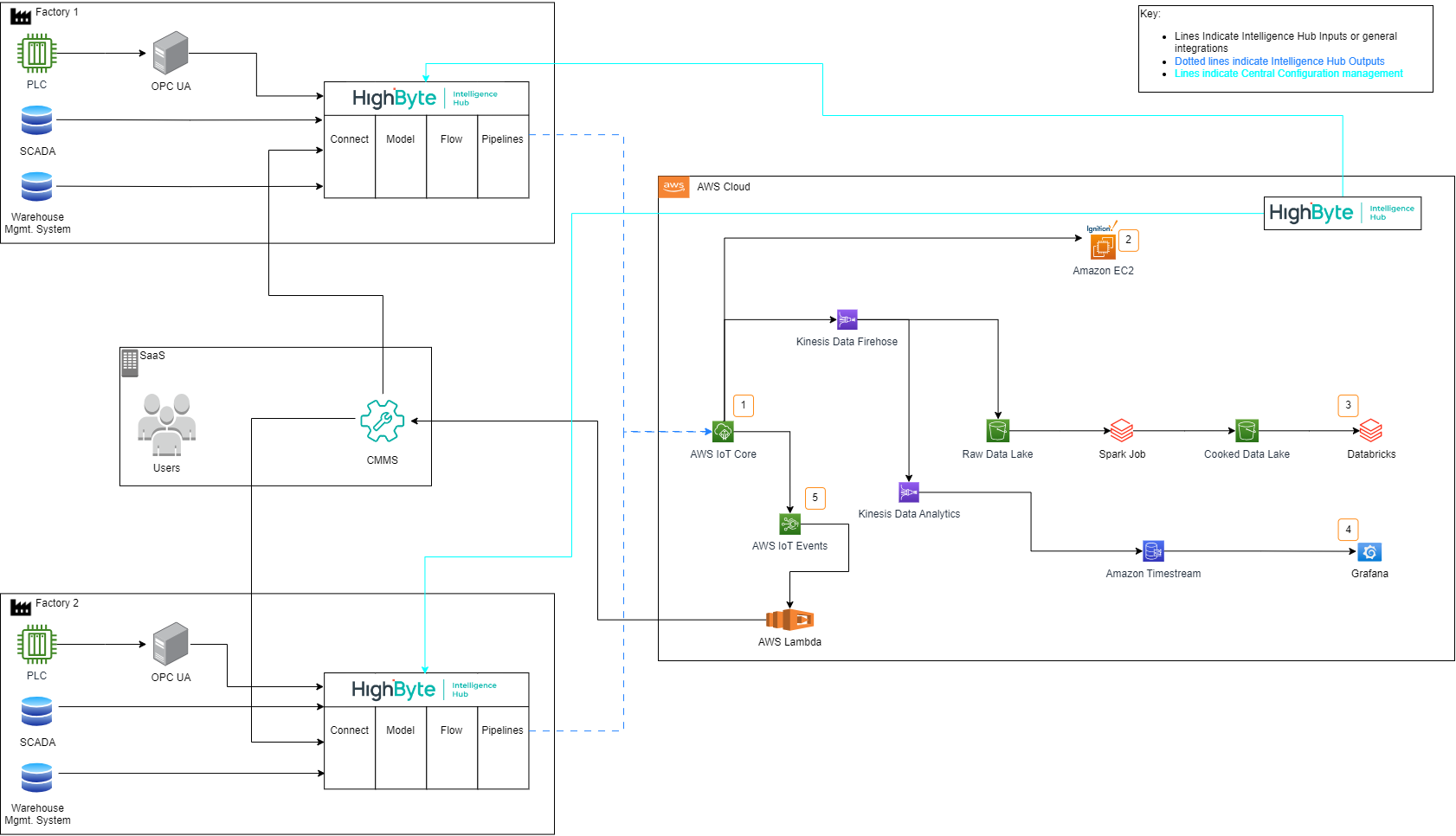Reference Architecture: Machine Utilization Data to AWS
What Does This Article Cover?
This article will provide a reference architecture focused on enabling Industrial data analysis within AWS.
- General Deployment Guidelines
- Reference Architecture Diagram
- Use Case Overview
- Summary
- Other Resources
General Deployment Guidelines
- It is recommended to install the Intelligence Hub as close to the data source(s) as possible to ensure optimal access to the source data. The occasional unavailability of the output destination can be effectively managed with the Intelligence Hub’s Store and Forward feature. This feature, designed as a failsafe for rare occasions when the output cannot be reached, buffers the data locally in a SQLite database and forwards it once the output target is accessible again. Deploying Intelligence Hub at the edge thus leverages this capability to enhance data integrity and reliability.
- Intelligence Hub is licensed by physical site, 1 license supports unlimited installations for the licensed sites. This enables flexible deployment strategies to deploy the Intelligence Hub by use case, by line or other methods.
- HighByte encourages users to apply the DRY (Don’t Repeat Yourself) principal when building use cases in the Intelligence Hub. Ensure Models are built with re-usability in mind. Consider using templating to quickly scale use cases from one point to many.
- When use cases span across multiple sites, HighByte recommends licensing a Central Configuration environment within a data center or cloud environment. This will provide users a single access point to easily manage and distribute configurations.
Reference Architecture Diagram
The following utilizes 3 Professional Intelligence Hub licenses. Use cases are focused on connecting disparate data from OT systems, modeling and outputting to a centralized location to enable various analytics using AWS cloud services. Please note this is a generalized diagram and many other use case possibilities are possible.

Use Case Overview
This reference architecture features multiple factories modeling the majority of their asset utilization data at “the edge”, to ensure the proper context and standardizations are applied before outputting to AWS. This includes creating an ISA-95 hierarchy for complete asset visibility (Site/Area/Line/Cell, etc) as the data is outputted to AWS IoT Core.
This section will provide additional information on the many use cases this architecture enables. The corresponding numbers align to the references within the architecture diagram.
-
AWS IoT Core: Intelligence Hub outputs data to the enterprise MQTT broker, AWS IoT Core. This acts as the enterprise Unified Namespace to provide a centralized repository of structured industrial data, in which any application or device can subscribe or publish data to. Using Dynamic Referencing, we can leverage key attributes from our payload and ensure the outputs automatically generate our ISA-95 hierarchy. The following could represent a standard output target where each {{this.Attribute}} will extract the value and dynamically build out the MQTT topic structure:
- Output: {{this.Site}}/{{this.Area}}/{{this.Line}}/Assets/{{this.AssetType}}/{{this.AssetID}}
- Result: Site1/Area1/Line1/Assets/Motor/Motor001
-
Ignition: In this example, Ignition is hosted in an AWS EC2 instance. Regardless of where the SCADA or IIoT platforms are hosted, these systems can subscribe to specific topics in AWS IoT Core to enable OT engineers to utilize the required data for various purposes such as descriptive analytic use cases.
-
Databricks: Data streamed to Databricks to enable machine learning use cases. Focused on predictive analytics, which will increase operational efficiencies and reduce overall costs.
-
Grafana: Using Kinesis Data Analytics and Amazon Timestream, data is delivered to Grafana which can be used for visualization of key machine utilization metrics. The consumer of these dashboards could be operational or business personnel to support OEE or preventive maintenance use cases.
-
AWS IoT Events: Monitoring of equipment state in AWS IoT Events allows for Lambda functions to automatically raise work orders in CMMS solution to support preventive maintenance use cases. The data in AWS IoT Core is already modeled in an ISA-95 format, the key pieces of context (Site, Area, Line, Cell, etc) can be utilized for this automation.
Summary
This architecture utilizes a central Intelligence Hub environment within AWS to easily distribute use case configurations from one instance to another. This ensures use cases and common data models are easily distributed to each licensed location via the Central Configuration node. Users can navigate to all remote instances from this one central instance.
With this architecture, Data Engineers can ensure data is modeled and outputted with the necessary context and standards to AWS IoT Core. This enables many different use cases and paths of the Industrial data. The Hub and Spoke model also simplifies the required integrations from factory to cloud.